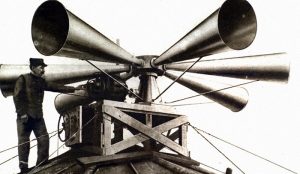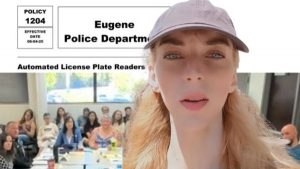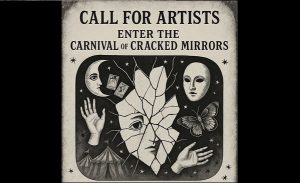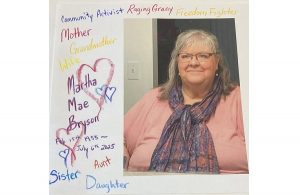LTD unveils new framework for public outreach, but is it too late for Franklin Boulevard?
13 min read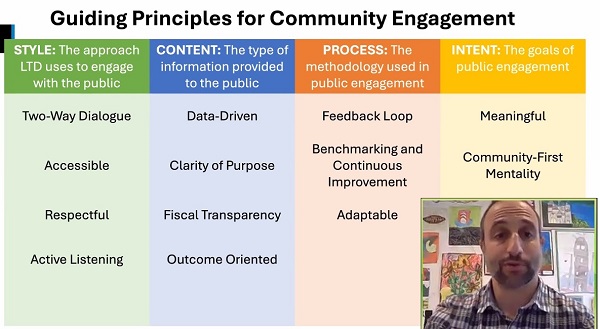
The Lane Transit District hits the reset button on public engagement, after widespread community opposition to three big projects, all promoting its Emerald Express bus rapid transit system. The Transit Tomorrow project sought to eliminate neighborhood routes to favor more frequent EmX service; MovingAhead sought to add EmX on River Road; and now a current project, Franklin Boulevard, has drawn criticism for reducing vehicle access to businesses, for promoting roundabouts, and for cutting off a long-established neighborhood. At the Strategic Planning Committee March 26:
Joshua Schank (LTD consultant): Well, hello, everyone. Joshua Schank with InfraStrategies. We were brought on to help LTD to figure out how LTD can better engage with the community. The idea is that in order to be successful in engaging with the community and deal with some of the challenges that LTD has had in the past, it was necessary to do a reset and to start over and think, ‘Okay what, is community outreach going to look like going forward?’
[00:01:08] And the product of this effort is the community outreach framework. The idea is that this framework will be the guide for how staff and consultants will work with the public on projects and future LTD initiatives. And notice, it’s about working with the public. That is language that you’ll see reflected in the framework itself, that this type of engagement is intended to be wholly collaborative… The real meat of it is: What are the strategies and tactics that LTD will use for engagement going forward.
[00:01:41] John Q: An initial survey found that most people didn’t know how to engage with LTD.
[00:01:47] Joshua Schank (LTD consultant): When we were asking people about how they give feedback or how they they’d like to give feedback, most were not aware of LTD projects—and we surveyed the community pretty fairly. That’s an interesting finding. Most also did not know how to give feedback and/or did not think that their feedback would make a difference. So that was kind of the starting point is that the awareness of LTD is not as high. The project is not as high as it could be, and people don’t know how to give feedback.
[00:02:18] So as far as the interview findings, we got the sense that stakeholders believe that LTD needs to first focus on developing and communicating the problems they’re trying to fix, before they propose solutions. This was a consistent finding that guided a lot of what we did. People did not want to be presented with a solution to a problem. They wanted to be presented with the problem and discuss potential solutions, and that’s a big difference.
[00:02:46] John Q: The LTD board is appointed by the governor, rather than being elected by residents of the districts they represent.
[00:02:53] Joshua Schank (LTD consultant): There’s also a desire for the board to play a larger role in community engagement, which was interesting. People felt like they didn’t know much about the board and their role in community engagement and that the unique structure of the board at LTD made community engagement less of a natural thing than you might see at other agencies, where, for example, board members are often elected officials from the very communities that they represent, they’re more likely to be playing that role. In this case, there’s a desire for them to play a greater role.
[00:03:23] We also found that the business community believes they should have a bigger say in the decisions of transit planning. However, the financial return of businesses cannot be the only way that we measure whether success is happening in the region. So that’s an interesting kind of balance that you have to strike in community engagement.
[00:03:45] And then finally, we found that there’s an opportunity for LTD to employ boosters and utilize supporters who really want LTD to do better and to help advance their priorities, but don’t feel like they’ve been engaged sufficiently to do that. And that’s a real great place for LTD to engage and get more support by finding those allies and working with them.
[00:04:08] So the next phase was, we put together this ad hoc Community Steering Council (CSC). We invited people from the public to apply, and then curated a group of more than 20 people, that it was as diverse as we could make it. We made sure that we had representatives of very different components of the community in that group. So these are the big questions that we put to the council in order to get their input:
[00:04:37] We started off asking about their transportation and mobility priorities because, after all, LTD is a transportation and mobility organization. And so we wanted to hear what people’s pain points were, what they were thinking about as far as those priorities. But then we got quickly into: What are the principles that we want to set for community engagement? We asked people about the stakeholders and their varying needs. We discussed the strategies and tactics that we might use given those stakeholders. And then we forced the people on the committee to prioritize the tradeoffs for engagement, because LTD can’t do everything everywhere all at once. It has to prioritize how it’s going to use strategies and tactics.
[00:05:21] John Q: They arrived at four guiding principles: style, content, process, and intent.
[00:05:25] Joshua Schank (LTD consultant): As far as style, there’s the principle of a two-way dialogue, meaning that if this is not just LTD giving out information or LTD just receiving information, it’s both and it’s happening at the same time, so that it is a two-way feedback; that it’s accessible, that people can get to it and be a part of it, and that in fact, LTD makes an effort to ensure accessibility for everyone in the community; that it is a respectful dialogue by both sides, that LTD respects the community’s perspective and vice-versa, and that there’s active listening as a style of engagement, that people are really trying to hear what each other’s other has to say, not just trying to speak past each other or demonstrate how loud their voice can be.
[00:06:11] As far as content, the idea here is that the content should be data-driven. That was a principle that people emphasized on the council, that it should be clear what the content’s purpose is, why are people being told what they’re being told or why is this the content that’s being discussed.
[00:06:29] That there should be fiscal transparency was a critical issue. Even if that news isn’t good news, people want to know what the fiscal situation is so they can make or provide good input for making good decisions, collaboratively. And that the content should be outcome-oriented rather than focus on what’s happened in the past or what exactly is happening now. ‘Where do we want to get to’ was being the principle for how that content is provided.
[00:06:57] And then as far as process, I really talked about two-way dialogue. The other side of that is the feedback loop so that when LTD hears something, it’s not just that they hear it, it’s that they report back on how they’ve used that feedback in what they’ve done. Whether they’ve used it or not, they’re not going to use it, they should tell why it’s not been used, but that that loop is continuous so everyone knows as trust that what they’re saying is actually being heard and used.
[00:07:23] That there’s benchmarking and continuous improvement so that this is not just a process that is set in stone but that we’re looking at how are we doing and what can we do to improve it all the time and that it’s adaptable to changing circumstances because circumstances will certainly change in the community and at LTD.
[00:07:40] And then finally, the principle of intent, that the goal of public engagement is that it should be meaningful engagement. This is not a box-checking exercise. This is intended to be meaningful for both sides. LTD gets something out of it, the community gets something out of it. And then that there’s a community-first mentality in the sense that LTD is out there to serve the community. That’s their job and that is the intent with which they should conduct public engagement.
[00:08:06] John Q: After identifying those four principles, the consultants asked the Community Steering Council to propose strategies and tactics.
[00:08:16] Joshua Schank (LTD consultant): And so then getting to the proposed strategies and tactics that we developed with the CSC. Number 1: Work to build trust with the community and not just when there is a project, but at all times.
[00:08:29] The relationship has to be solid so that when some big change is being proposed or when some big project is coming up, the community trusts that LTD is not just showing up. up now because they have a project on tap but they actually care that they have a relationship and that relationship continues regardless of whether there’s a project.
[00:08:47] Second, Partnering with the existing organizations to build trust. LTD can’t do this on its own. There are lots of organizations out there that have better relationships or existing relationships with communities use those organizations to help build build that trust and put LTD in a position to better interact with the community.
[00:09:07] Focusing on existing riders and meeting them where they are and working to improve their experience. This is an interesting and important strategy because LTD is not largely funded by the riders. They are funded largely by the business community, but there was a strong feeling by the CSC that focusing on the riders was very important, and that meeting them where they are really finding those riders and working to improve their experience needed to be a major component of community engagement.
[00:09:34] The CSC also suggested anticipating potential opposition and engaging that opposition early as a key tactic. That’s something that many public agencies do when they see that there could be strong opposition to something that needs to happen. It’s really important to bring those folks into the fold early.
[00:09:54] As I discussed earlier, following up after interactions to make sure that people understand how feedback is being incorporated, even if it’s not being incorporated, just to make sure they understand why it’s not being incorporated, being transparent about that is really important. And similarly, being transparent about the hard truths and not shying away from those, being honest. That’s how trust gets built—is by sharing those hard truths and understanding what the real challenges are and working together to solve them.
[00:10:23] And that’s what the last one is about too: being upfront about boundaries and limitations. Not just about LTD’s, but also what the public has to deal with. There are real boundaries and limitations and engagement has to recognize those so that LTD can work collaboratively with the community within those boundaries and limitations.
[00:10:42] And then finally, we did ask the CSC to prioritize strategies and tactics. And these are the four that they really thought were most critical, if you really drill down a little bit.
[00:10:52] One, engaging government stakeholders. It’s going to be very difficult for LTD to be successful in this community without working with other government stakeholders on their issues that they care about, and also on the issues that their communities care about. So engaging with government stakeholders was a key tactic.
[00:11:09] Getting out ahead of the story. So putting out what LTD’s version is of the story when they’re engaging, when they’re working on a controversial topic, is really important. It’s very natural for the press to characterize stories and focus on negative stories, and getting out there and making sure that the other side of that story is told is really important.
[00:11:31] Being present with riders, whether it’s on the system, whether it’s through surveys, whether it’s at the stations, being there and being a part of it, riding the service should be something that LTD does, that its board members do, that its executives do, that everybody does. And being out there and being a part of it, that will go a long way towards far better engagement and understanding of each other’s positions.
[00:11:52] And then finally, Engaging the potential opposition, working with the people who might present a challenge, bringing them in, not treating them as a potential enemy, but instead, how can they be brought in as allies and partners in achieving the larger goals that people care about.
[00:12:08] John Q: The findings suggest an ongoing relationship, instead of the current project-oriented approach.
[00:12:18] Tom Schwetz (LTD director of mobility planning and policy): I mostly engage the community through different projects that we do. And it’s like, the community’s out there, ‘Oh, we’re doing a project. Hey, here I am,’ you know. And we have other processes in the organization, passing the budget, you know, all those kinds of things that are published.
[00:12:34] And what we’re taking away from this is: Our relationship with the community needs to be ongoing and continuous. And we’re going to meet new people. And over time, those people are going to be different people. And we just have to have that orientation of engaging with the full community on an ongoing basis, because we’re the transit provider and we want to make sure everybody has what they need and that you know we’re getting what we need to do the best we can.
[00:13:02] To me, that’s how I am taking that. It’s a really different orientation.
[00:13:12] Rob Zako (Better Eugene Springfield Transportation, executive director): Thank you for the presentation, for this work. This sounds like best practices in the industry and good principles for how to engage the communities. I guess I’m curious what comes next after that because it’s a set of principles and not necessarily answers for tonight, but I guess the proof is in the pudding. So I’m wondering how does LTD actually engage these principles to do things differently along River Road, around MovingAhead.
[00:13:37] We have some ongoing conversations that have been hard with the community. So I’ll be interested to see how this plays out differently than it has in the past.
[00:13:50] Pat Walsh (LTD, chief marketing officer): I can answer that, Rob. We have to operationalize it. We have to be intentional about it and we have to use that document and apply it to the projects that we’re working on. And that’s going to be our responsibility internally to do and we expect to be held accountable for our work on that. Is it going to look the same on every project? Probably not, but it has to look pretty close. So that’s, I think, the exciting part of the work.
[00:14:14] It was great to work with the CSC and be involved in all of this to date, but the exciting part is ahead and that is how it is we flip the script on this thing in terms of our community engagement and our community participation.
[00:14:27] And it’s not a one-and-done with every project. It has to be an ongoing thing that the district is engaged in, on everything we do. As you’ve said, the proof is in the pudding. And I think that’s the exciting, delicious part of the pudding.
[00:14:43] Jameson Auten (LTD, CEO): Back to Rob’s question and echoing Pat, the baseline of this process, of this framework, is trust, building trust. And for us to build trust, we have to deliver on what we’re selling, right? So that’s what we’re going to do as an organization. We have to be consistent in how we deliver and has to be scalable to the project.
[00:15:02] And, you know, the beautiful thing about Eugene (I was talking about this today where I’m at in the conference) is that we have an engaged community. That’s the beautiful thing. The other side of it is that we have an engaged community, right, that’s the other side as well.
[00:15:18] So there’s a lot of perspectives and a lot of opinions and a lot of ways that people carry out business that we have to be prepared as the organization to be able to make sure we deliver on our end, make sure on our end that we’re communicating as best we can, that we’re engaging, and that we’re really soliciting the feedback that we need.
[00:15:38] The other side of it is, Rob, is that we’re not disengaging the CSC. We’re not disengaging that council. We want to have a feedback loop on how are we doing, because this is another iterative process, right? It’s not fully baked and done. It’s an ongoing conversation, an ongoing process. So as we learn how to better communicate with our community, we’ll adapt and modify and go from there. But keeping that council in place and that feedback loop in place is vital to us moving forward.
[00:16:08] John Q: LTD follows through on a promise made by its CEO in one of his first public meetings. At Santa Clara on March 3, 2023:
[00:16:17] Jameson Auten: We recently kicked off a community assessment on how we do outreach, so that we can look at what best practices outreach actually looks like, if there is such a thing, and if there is, have it right here in the Eugene / Springfield area… We’re going to deliver on a level of accountability, a level of outreach, and a level of engagement that I’m not sure you may have seen in the past.
[00:16:41] John Q: The principles, strategies, and tactics are now in place, but without an elected board, accountability will fall to the staff. If the proof is in the pudding: Will LTD apply its new approach to community engagement to the Franklin Boulevard project?
See also: City promotes friendlier Franklin as ‘the spine of EmX’
